What companies really want from executive courses

Roula Khalaf, Editor of the FT, selects her favourite stories in this weekly newsletter.
Employers around the world plan to step up their spending on executive development programmes this year with a focus on leadership, diversity and digital transformation, according to the FT’s second annual chief learning officer survey.
More than 56 per cent of 142 polled CLOs — managers who oversee training — expect larger budgets in 2022, with over a third saying spending would be stable, and less than 9 per cent expecting a cut. The figures suggest a redoubled commitment to learning in the wake of Covid, at a time when training is seen as important for growth through reskilling and as a tool to recruit and retain senior staff.
More than 37 per cent of surveyed organisations plan between one and five executive learning programmes with external providers during 2022, and a further 11 per cent plan between six and 20 courses.

Digital transformation, digital skills and sustainability were higher CLO priorities this year
The most important topic for training — cited by nearly three-quarters — was leadership, followed by diversity and inclusion and digital transformation, both of which were mentioned by more than half of respondents.
Other popular topics were change management, innovation, digital skills, strategy and data science, at more than a third each. Interest in sustainability rose from 23 per cent when CLOs were surveyed in 2021 to 31 per cent this year, ahead of wellbeing and resilience.
In a reflection of the greater use of technology, lower costs and the greater convenience of hybrid learning since Covid-19, three-quarters of organisations’ executive courses are now taking place at least 50 per cent online. However, interaction between participants remains important. Respondents said two-thirds of courses this year would be taught online synchronously — studying at the same time — or using blended online and in-person teaching. Just over a fifth of courses will remain purely in person.
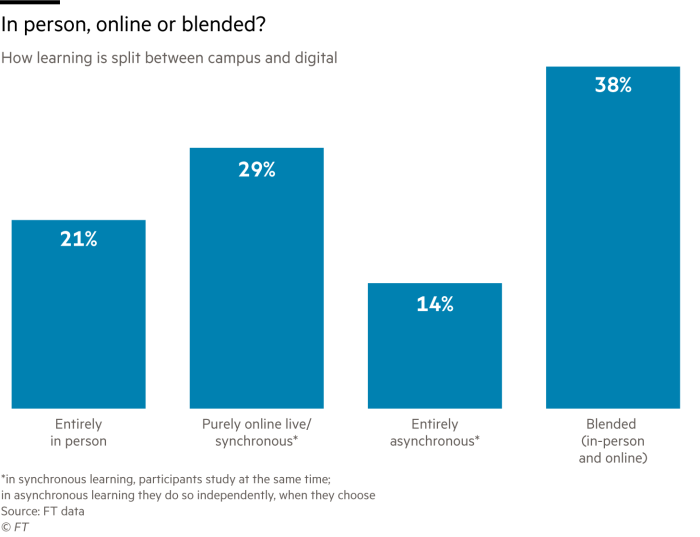
Blended learning, which mixes online and in-person study, accounts for the largest segment
Following the inaugural CLO survey last year, the FT again partnered with Unicon, the university-based executive education consortium; Embac, the executive MBA network; the two leading accreditation agencies AACSB and EFMD; and Nomadic Learning.
Most of the respondents were heads of leadership development, chief human resources officers, chief learning officers, human resources directors or had similar titles. Two-fifths represented organisations with fewer than 1,000 employees; nearly one-fifth had more than 20,000.
Respondents were drawn from the education, finance, banking, industry, healthcare, consultancy and telecoms/IT sectors, among others. More than three-fifths had responsibility for staff in Europe; two-fifths oversaw employees in north America; and nearly one-fifth in the Middle East, central and Latin America and Africa.
Most respondents said their learning budgets were focused on mid-level managers or functional heads, who were targeted to receive over a quarter of spending. One-fifth was designated for senior managers and emerging leaders, and 14 per cent for C-suite executives.
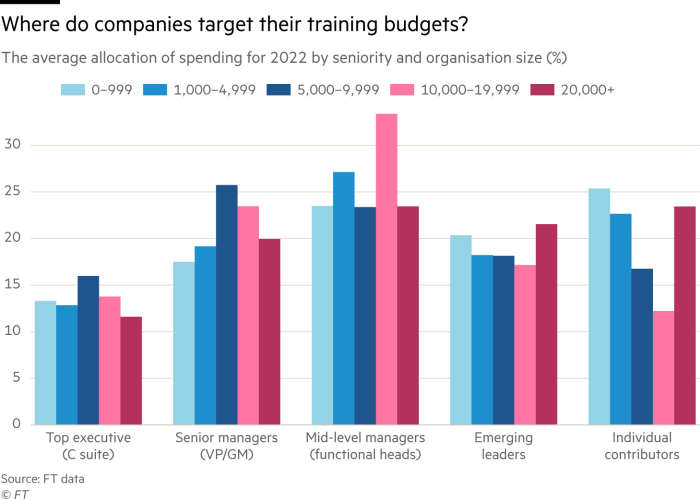
Much of companies’ executive education spending is focused on mid-level managers
The majority either “somewhat” or “strongly” agreed with the statements that they had been able in the past two years to bring learning more “broadly and deeply” into their organisation, and it was more aligned than in the past with specific business needs and strategic initiatives.
Similar proportions said executive development would become more personalised and self-paced, with the ability to customise considered the top-ranked quality of a provider according to 46 per cent of respondents.
Many CLOs stressed that they were rethinking eligibility for executive development, with a greater focus on including those identified via personal development programmes and succession planning. A number cited the importance of personality tests, pre-course assessments and awareness-raising to encourage more applicants.
Another quality favoured by respondents, cited by 14 per cent, was cutting-edge knowledge, followed by assurance of learning, research-based or empirical knowledge, the ability to demonstrate return on investment, cost-effectiveness and a robust interactive online platform.
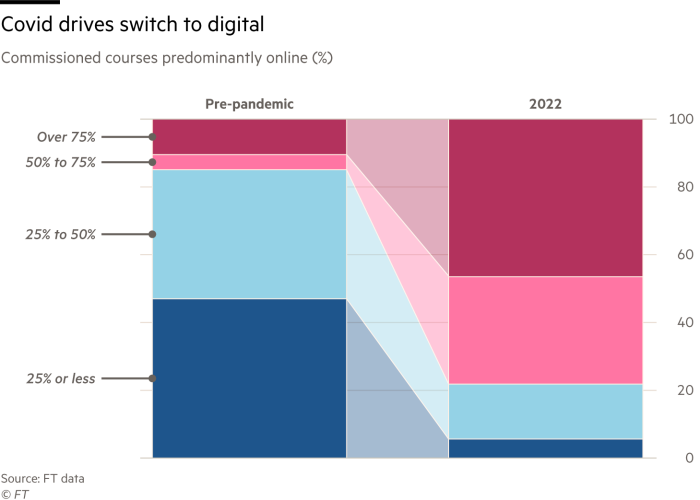
The proportion of courses taught mainly online has grown significantly during the pandemic
One respondent called for “innovative pedagogy, more personal development than knowledge provision”. Another stressed the “ability to provide learning solutions that can be easily scaled up”. A third wanted the “ability to blend the partner’s knowledge with our corporate specific[s]”.
Another respondent argued for “partners that actually understand and have operationalised how people learn. Most of these [trainers] don’t know much about learning and instead just churn out ‘solutions’ that aren’t based on anything but their own personal experiences.”
In a growing search for value for money, the majority said that their criteria for evaluating candidates for executive education and assessing the success of programmes would change in future years.
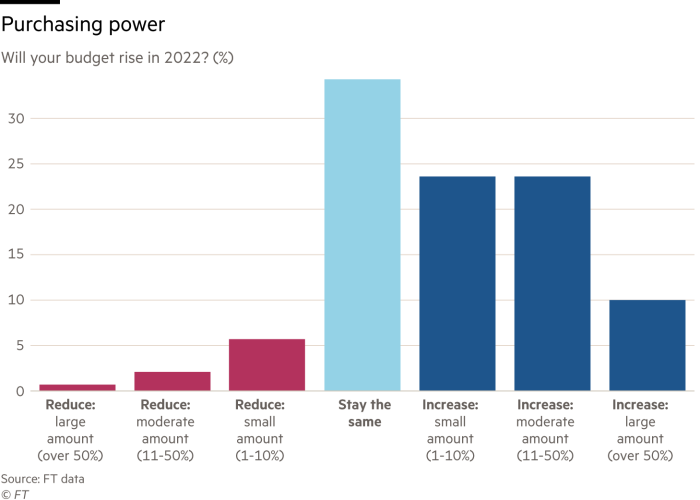
More than half of chief learning officers say budgets will rise in 2022 vs 2021
One respondent wrote: “We’re in [the] early stages of our thinking. There has been such under-investment that there are a lot of basics to support.” A number cited growing interest in measuring return on investment in executive education, with one warning: “The bar has been raised — outcomes are expected.” Another said there would be “more focus on business results and career development”.
Others cited the use of pulse surveys — regular questions sent to staff — feedback sessions and pre- and post-course assessments to help with selection and evaluation.
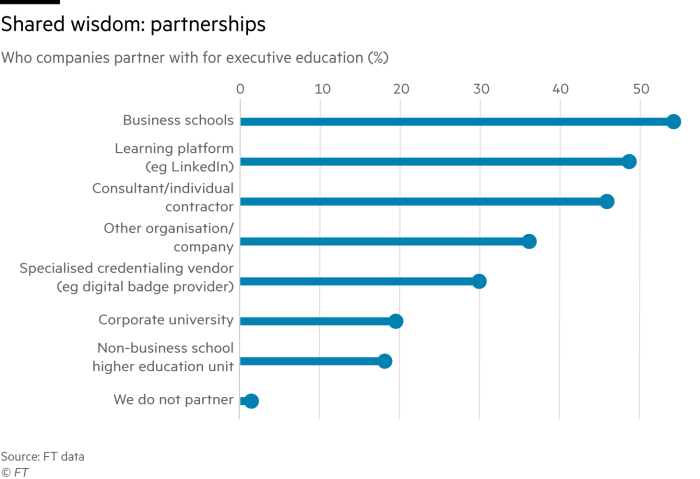
Business schools are companies’ top choice of external partner but other options are close behind
Business schools remained the most common external partner for learning, used by 54 per cent, followed by external platforms such as LinkedIn and consultants. Nearly one-fifth used corporate universities or higher education units that were not business schools, and about 1 per cent did not partner with anyone.
While just over half of CLOs said they would use universities, including business schools, as partners for professional development this year, 73 per cent planned to use non-academic external sources and 62 per cent would rely on their own company-developed resources.
Graphics by Chris Campbell
Comments